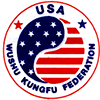of USAWKF
|
The widely used term QiGong (Chi-Kung) used to refer to the Indian/Chinese Meditative Practice and Body Conditioning, is derived from several branches of Internal and External methods of analysing and methodologies for modifying the human body's internal functions, health, and longevity. These medical and analytical branches of Qigong predate Buddhism and Taoism in China and in India. When Shaolin Monks were falling ill and often attacked by desperate people to steal the monk's storage of food, an invitation was sent to India for a Buddhist monk to come teach Buddhism. This was Da-Mo or more broadly known as Bodhidharma. Bodhidharma immediately observed that the Shaolin monks lacked greatly in physical health and as a result were not only unable to protect their temple from attacks, but were unable to practice effective meditation or exercise. Bodhidharma then secluded himself in a cavern on a nearby mountain and meditated for years to produce two books of instruction to strengthen the monks for health, and teach them meditation techniques for enlightenment. These were the Yi Jin Jing (Muscle and Tendon Changing) and the Xi Sui Jing (Brain and Marrow Cleansing) methods. These would latter become known as a system of movements and mental concentration called TaijiQuan (Tai Chi Chuan). Do not confuse this ji (chi) with qi (chi). Taiji is about EMF or electromotive-force (volition) enacting the Life energy (Qi or Chi) to act. The result or manifestation of that action is Quan or Chuan. In the West the name Taijiquan is often shortened as Tai Chi, but this is absolutely wrong as the entire purpose of Da-Mo's writings of method necessitates the use of BOTH the physical development along side the mental or Shen development. As the Buddhist methods for enlightenment were integrated into the Taoist monks, there developed two branches of development to achieve the same end goal. Buddhist Qigong became more focused on the Xi Sui Jing for cleansing brain and marrow to lead more quickly to enlightenment at the possible detriment to longevity, while Taoist Qigong followed more the Yi Jin Jing muscle and tendon path for longevity to have greater time or longevity to attain enlightenment. Because we at Threefold Lotus Kwoon deal with both Buddhist methodology and Martial Skills, we will spend equal time as Bodhidharma intended in the study of these great classics of meditative practice and support the student's preference as they chose. The goal remains the same; a healthy life to attain enlightenment. In the case of the Shaolin monastery, the Yi Jin exercises developed into several styles of GungFu or Kung Fu, while the use of the Xi Sui meditation methods were directed at Buddhist spiritual or Shen development. In other monasteries the monks adopted the Taoist view of Shen development and those were generally known as Wudang monasteries. Both Shaolin and Wudang practiced for the same goal with some important variations.
The widely used term "Kung Fu" used to refer to the Chinese Martial Arts, is mostly a "Western" and English convention adopted during the 20th century. The term "Kung Fu" is seldom used in China itself either in written or spoken language other than regionally in a Cantonese dialect. The popular Chinese term, in both Mandarin and Cantonese, both in written and spoken form, which comes closest to the concept of Kung Fu as it is commonly known to Western users is, quanshu or quanfa (the q pronounced as Ch). Quanshu means the art of the fist, quanfa, the techniques of the fist. The terms quanshu and quanfa also suggest some conceptual difference from the more holistic and inclusive term wuyi, which in earlier terms included archery and horse-riding In Chinese, Shaolin Kung Fu is referred to as Shaolinquan; Bagua Kung Fu as Baguaquan; Praying Mantis Kung Fu as Tanglangquan, and so on. Quan, which literally means fist, is the short form of quanshu or quanfa, and refers not just to the use of the fist, but to the whole system of Kung Fu, including the use of weapons and methods of force training. All the various styles of Kung Fu came after Shaolin, and almost all - if not actually all - developed from Shaolin Kung Fu.
When the Manchus established the Qing Dynasty (1644-1911), the government encouraged wuyi (martial arts) in the army, but discouraged it amongst civilians. Many Manchurian generals and administrators were great Kung Fu masters. The public maintained the practice of martial arts in private schools and clubs. In this way, features like individual fighting, unarmed combat, set practice for health and demonstration were emphasized. Other aspects of Kung Fu like military strategies and formations, archery and horseback fighting were neglected. This gradual evolution resulted in the concept and content of Kung Fu that is familiar today The Qing period was important for the development of the internal styles of of Kung Fu. Taijiquan (Tai Chi Chuan), which had earlier evolved from Shaolin Kung Fu, became widely practiced in northern China. The other two major styles of internal Kung Fu, Bagua (Pakua) and Xing Yi, were established. In southern China, Shaolin Kung Fu prevailed. The Southern Shaolin Sanctuary in Fujian Province became the rallying center for revolutionaries aiming to overthrow the Manchurian government. The Manchurian armies destroyed the sanctuary and Shaolin masters dispersed themselves to Quangdong Province, Hong Kong, South-East Asia, and North America. One of these masters was the Shaolin Monk Jiang Nan, who transmitted the Shaolin arts to Yang Fa Kun. Yang Fa Kun transmitted the arts to Ho Fatt Nam who transmitted the arts to Wong Kiew Kit. Grand Master Wong Kiew Kit has had the generosity to transmit these arts to me. Doctor Sun Yat Sen's successful revolution of 1911 brought the long dynastic history of China to an end. Many of the revolutionaries were Shaolin disciples. Numerous martial arts organizations sprang up, the most important being Jing Wu (Ching Woo) Athletic Association, which was founded by Kung Fu expert, Huo Yuan Jia, and had branches in many parts of China and South-East Asia. In 1926 the Kuomintang government changed the term Wushu (martial arts), which was in common use at that time, to guoshu, meaning "national art". Ironically, the standard of guoshu deteriorated further into "flowery fists and embroidery kicks" for demonstration during this period. Two reasons were the development of firearms, greatly reducing the need for hand-to-hand combat, and the Kuomintang government only paid lip-service to the promotion of guoshu. For instance, the Kuomintang army in Taiwan today is trained in taekwondo instead of guoshu, their national art! In contrast, the Communist government which replaced the Kuomintang in China has done a great deal to revive the glory and greatness of Chinese martial arts, which they renamed Wushu. There are working committees at national, provincial and district levels to study and promote the arts; specialized wushu schools and colleges have been established; and national and international wushu tournaments are held. Wushu is already included in the Asian Games and is expected to be included in the Olympic Games. The most important contribution of the present government in China to Wushu, is the restoration of the sacred temple of Kung Fu, the fabulous Shaolin Sanctuary, which spells magic to many martial arts enthusiasts throughout the world.
The TLK (Threefold Lotus Kwoon) is
dedicated to the enlightenment of humankind. As such, we value the sanctity and ultimate value of human life. |













